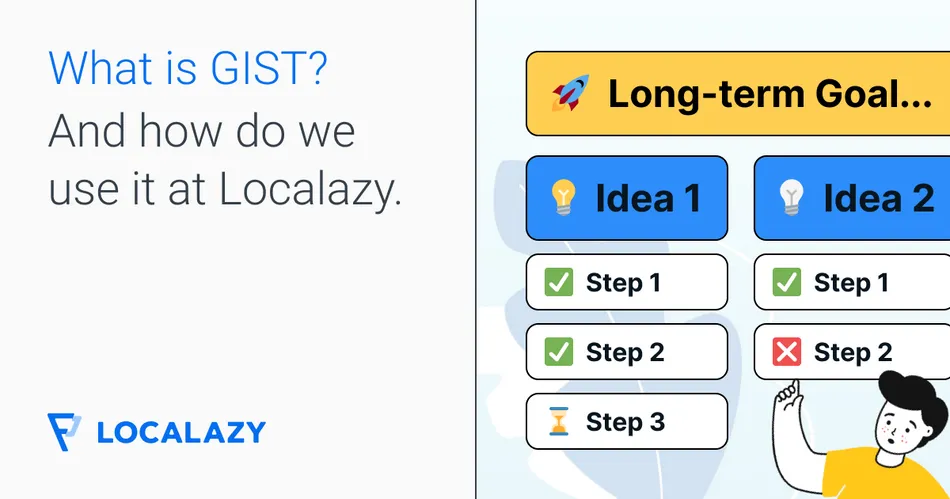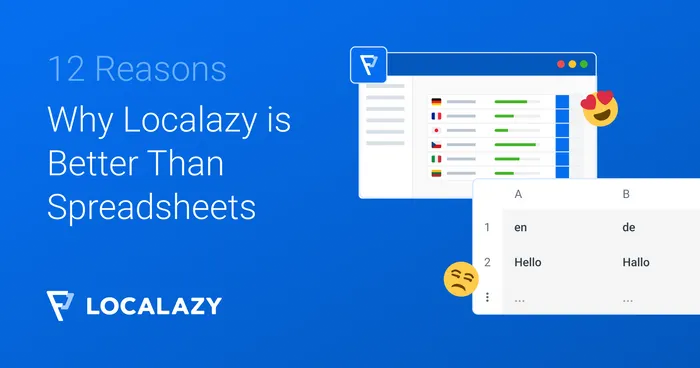Every entrepreneur knows that creating a successful business model is very much trial and error. You can have great ideas and innovative solutions, sure - but it really boils down to how you put them in motion. ⚙️ And that's where the long-winded path of finding the perfect work management system starts.
Picking ideas with the most significant impact on our users and making them actionable via our small agile-based crew was initially easy for us. But when Localazy started to pick up pace and grow, managing an increasing remote team and an ever-flowing sea of customer input turned difficult. We needed a tool to make the right decisions faster, simpler, and better.
An Itamar Gilad's article on GIST and his subsequent book, "Evidence-Guided" -which just launched in September- was the spark that led us to a framework that has transformed how we work for the better. 🌟 And thanks to the enthusiastic efforts of our Product Manager, Jan Bílek, and CMO, Jakub Dubec, Localazy is now GIST-powered.
But what does that mean, and why does it matter? 🤔 Well, let us tell you the story.
💭 What is GIST? 🔗
The name 🔗
GIST stands for Goals, Ideas, Steps, and Tasks. It is a planning approach derived from the Lean & Agile Development principles and created by former Google manager and engineer Itamar Gilad. The framework combines these methods, which have often been used separately for years, into one flexible toolbox.
In a few words, GIST is an evidence-guided product management system that aims to help your business adapt and deliver faster, better, no-frills solutions for your customers.
🎙️ We invited Itamar Gilad on our podcast, Bridging the Gap, to discuss a his data-driven decision-making approach for launching in new markets
The story 🔗
Gilad was kind enough to share his personal story about developing GIST with Localazy: "I joined Google in 2010, partly because I was curious about how it became so successful in so many different things: search, advertising, video, email, browsers, operating systems… — a much higher success rate than the average in the industry. Over time I started to piece together a four-part model", he explains.
That model would become what he eventually would dub as GIST:
- Goals: focusing on the user was a constant at Google, as Gilad details. Goals there are "a very serious matter, and people and teams are expected to act on them." They had to be the stepping stone of this new framework. 🪨
- Ideas: creativity shapes startups. Ideas are encouraged, and even if most fail, "a small minority," as the ex-Google manager puts it, "become massive successes." The company was letting a thousand flowers bloom, and it eventually paid off. 🌺
- Steps: to test rough versions of these ideas, a small investment was allocated. "Product teams were expected to act on the evidence and iterate, pivot, or dump ideas," he explains. Two principles were followed: 👣 "Think big, but start small," and 📉 "Fail fast."
- Tasks: you can complete an infinite to-do list but keep getting underwhelming results. Something was different at Google, where agile was used, but strict rituals weren't enforced: "They succeeded in giving their developers more context, empowered product teams to make decisions, and didn’t just focus on output."
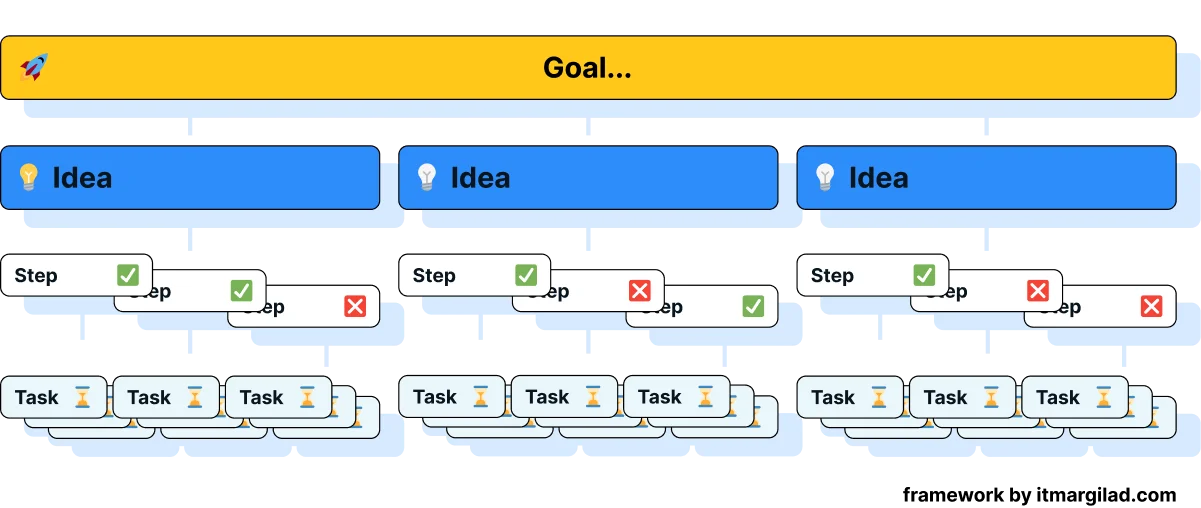
Gilad's observations were reinforced when the search engine giant implemented their Gmail Tabbed Inbox in 2010 following this approach. The goal (dealing with inbox clutter) led to exploring a number of ideas. When the team stumbled onto the right one (organizing the inbox by categories 📥), the process rolled on: a series of validation steps followed, confirming that the experience of target users was being improved, and the project grew until it hit its current 1.8 billion users.
"The launch was extremely successful, and the Tabbed Inbox was recognized as one of the most important changes in the history of the product. It was also a project everyone really enjoyed working on. After that, I realized I never wanted to work in the old way again," he says. The rest is history!
What makes GIST different from other agile systems? 🔗
The evidence-guided approach of GIST is designed to work in concoction with agile, taking this framework to the next level. But, as Gilad explains, there are some considerations that agile dev teams need to take into account before implementation:
- Switching to a wider approach: many agile teams focus on delivery. With GIST, the team is responsible for both discovery and delivery.
- Adapting to change quickly: restrictions need to be put aside when new information comes up. The team can choose to modify the initial plan, park an idea, or run a new validation step. This can happen mid-sprint.
- Making restrictions disappear: strict requirements don't make sense in a GIST-based team. Thanks to improved context, members understand what needs to be done without the fine print in the form of tickets and detailed tasks. Most details are, in fact, nailed down during discussions and development.
💡 How we use it 🔗
We switched the planning process to a GIST-based approach at the beginning of Q3/2023. Our tool of choice was, and is, Fibery. Two people were devoted to absorbing the concept and playing around with early prototyping. Once we felt ready, our CEO, Václav Hodek, was the first tester of the system.
Localazy adapted the original basic GIST principles to their needs:
🎯 Goals
We set quarterly goals in the form of OKRs, derived from more high-level strategic goals and company-level KPIs. Previously, we were experimenting with company OKRs, but we couldn't manage the work required to move them forward.
💭 Ideas
We started to keep track of all ideas in an Idea Bank. Each idea now has a goal (objective), while ICE scoring and statuses are applied to sort and prioritize them. Every item currently goes through different stages as we gather more information and evidence throughout the process. We use templates to help form our hypotheses and formulate reasoning.
🪜 Steps
We use steps to break down ideas into more manageable chunks of work and gather more details on the way. Steps often help us break down the idea into different teams as well.
📌 Tasks
Finally, tasks are planned into two-week sprints across all teams to split the necessary steps into concrete, actionable items. We use a simplified variation of SCRUM for this.
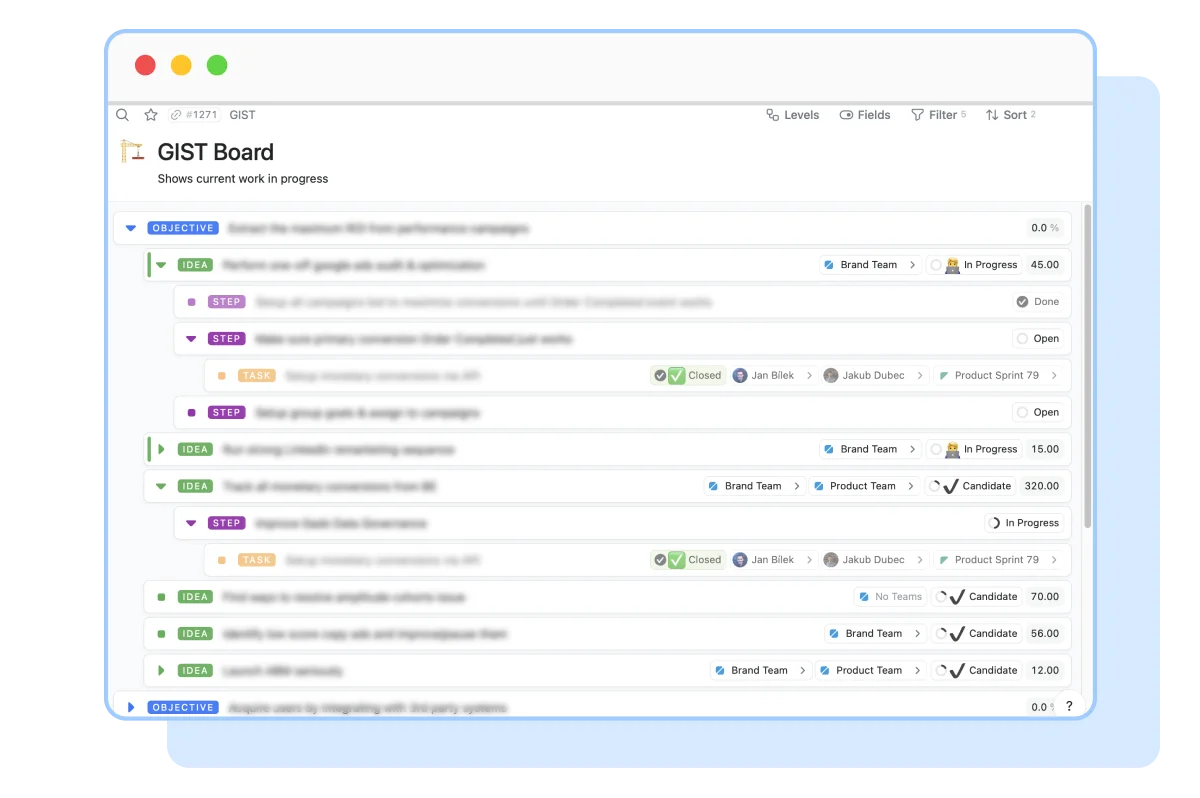
To track progress and explore the full context of what we are working on, we have an accessible GIST board where it's easy to see all framework components in a tree-like structure. Unfortunately, it's impossible to share screenshots or more detailed materials with concrete examples since our goals and what we're working on are sensitive info, and they cannot be made available to the general public.
During the process, we also added the Jobs To Be Done approach to the mix. This user research technique, based on customer problems rather than their attributes as users, helps us formulate our raison d'être, which is serving their needs as accurately as possible. "We are committed to addressing the painful points in the customer journey. It's become the driving force behind our mission, and the JTBD framework is how to manage them", explains our CEO Václav.
🌸 The benefits 🔗
On paper, GIST gives clarity to the company's goals and provides a pathway to generate ideas and track progress. When put into action, it encourages teams to experiment, iterate and learn.
Some of the immediate benefits we noticed at Localazy were the ability to reframe our perspective and work as a team, even on the more abstract company objectives. 💡 Ideas stopped getting lost or repeated unnecessarily on Slack: the new scannable and quickly accessible system allowed us to track every single one. Plus, our sync between development and marketing improved vastly, which ultimately led to better go-to-market performance.
What our team has to say 🔗
After a few months of running with it, here's what our team has to say about GIST:
"GIST allows us to collect and prioritize ideas and turn them into actionable improvements by providing a structured framework for idea generation, evaluation, and implementation. I already feel that we are more focused, which is great for business and our customers." - Václav Hodek, CEO
"The whole notion of idea development through stages of maturity is well-played by Itamar. The steps of idea implementation allow you to start small, experiment, gather feedback data and learn from previous steps. Amazing." - Jakub Dubec, CMO
"GIST arrived at the perfect time. We had received a new investment, hired new team members, and needed to reaffirm our goals and strategy. We were searching for a system that would bring clarity and context to our work, ensuring that we were ultimately solving the right problems and delivering the most impactful solutions bringing us closer to these goals." - Jan Bílek, Product Manager
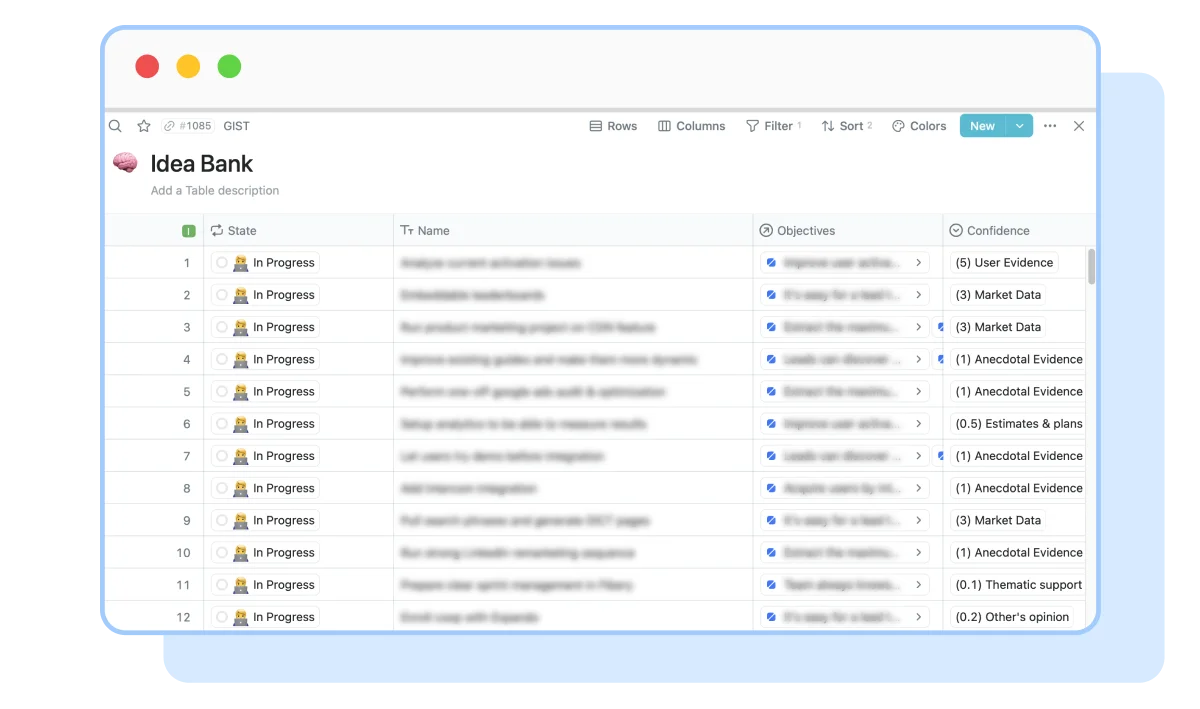
Improved satisfaction 🔗
The figures from an internal survey among the Localazy team support this feedback, as satisfaction levels greatly improved just weeks after the adoption of the new framework (from the former 4.3/10 to the current 7.7/10). 🥳 It's also worth noting that 100% of the team members interviewed about GIST would recommend this framework to other colleagues.
A better understanding of how long-term goals relate to daily work was the #1 benefit highlighted by our team, which also noticed priorities becoming clearer. This resulted in an improved understanding of the company's goals. As one of our members noted, "Suddenly, it all seems so clear, and one can easily see the bonds between levels of the structure."
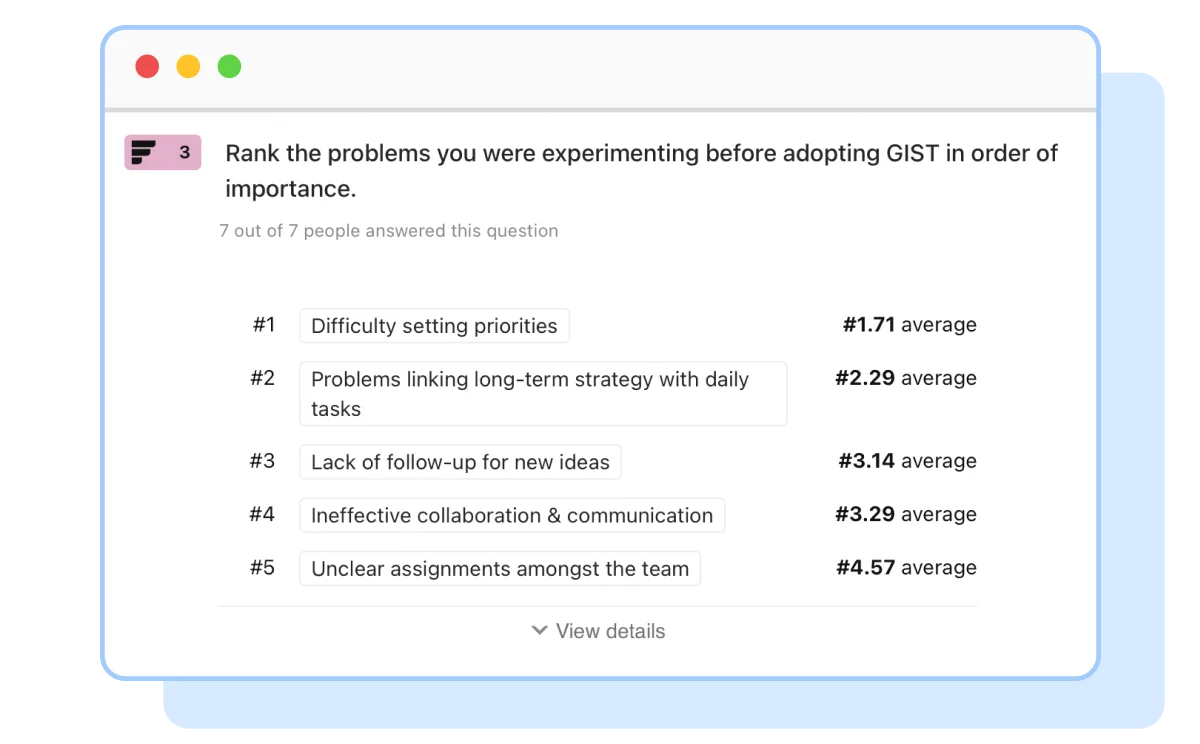
Communication also improved dramatically thanks to GIST. As a fully remote, 10+ people team with half of our members being completely fresh, having the company's vision, goals, and key results lined up more clearly was hugely beneficial for asynchronous work. 👩💻 This means that all the context is currently available for team members, so they are free to jump on any task or create their own, knowing they'll help the company grow without needing to sync at all times.
"Everything, even if not perfectly, is now written down. We are more focused and there are no worries that important ideas are lost." - Localazy team member
"Thanks to GIST, there is no space left for arguing about priorities while you fight for scarce resources, such as developer time," says our CMO Jakub, who also points out how setting ambitious goals and breaking them down into daily tasks has become much easier.
Problem ➡ solution 🔗
Before adopting GIST & JTBD, there were several problems we hadn't found an answer for. They have now been tackled. Here are some of the highlights, according to our PM Jan:
- Lack of high-level context when working on a concrete task in sprint. → Everyone in a team can now see what we're ultimately trying to achieve, resulting in better solutions.
- A missing connection between our strategy, goals, and everyday tasks. → All work is now trackable, both top-down and bottom-up. There's a visible indicator of progress.
- There's no system for storing, evaluating, and prioritizing ideas. → Idea bank + ICE + Goals helps us focus on what's important and filter out the noise.
- Ideas are missing proper evaluation and aren't well researched and framed before going to implementation. → Each idea has some stages, which evolve over time. This helps formulate them better and prioritize them based on concrete evidence.
- Cross-team collaboration is a real challenge. → Thanks to concrete steps and shared goals, teams can collaborate more effectively.
- Ideas are often left behind after release. → We can now track all stages of an idea, including evaluation and success reflection.
- Everyone needs to be assigned some tasks. → Team members can navigate the GIST tree and see where else they can be helpful.
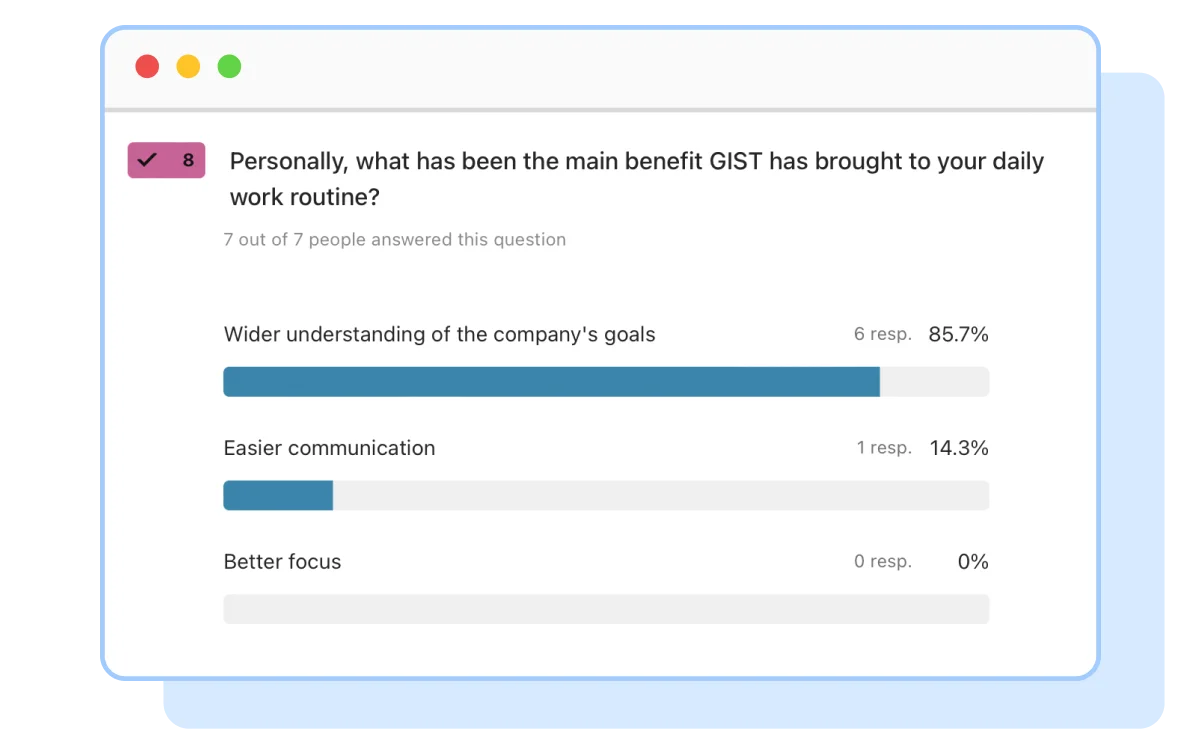
A practical example 🔗
A junior developer might not have a clue why our CMO wants him to develop embeddable leaderboards. He might be wondering how it will help the customer or, more importantly, how he can bring his own improvements to the original idea.
With a better set of developed ideas and a series of clear steps to follow, the process would look like this:
- 🔎 Objective: Increase the ratio of non-performance traffic.
- 🎯 Goal: Boost domain rate.
- 🪜 Step: Gain thousands of quality backlinks programmatically.
- 📌 Task: Create an embeddable leaderboard for community projects.
The red string tells the story! Using the shared boards, the junior developer can now bring his own brain into the job getting done... all thanks to GIST.

⚖️ Implementation & challenges 🔗
Implementing GIST into our day-to-day has been (and still is) a learning process. We'd be lying if we didn't recognize that some resistance was met - "mostly because it's not easy to adopt systems and processes and keep them running," explains our CMO Jakub. It was not our first try to formalize our efforts, and it wasn't an easy feat. However, we were able to overcome that challenge by making GIST work on top of the very current goals and sprint tasks.
Having our CEO on board was vital. "It was very important to signal to other team members we were serious about GIST," explains Jakub. After that, it was time to transfer all the materials into the new planning system before formally introducing it to the team. 🚛 With the summer holidays coming up, we took advantage of the time window as an opportunity to do so. Hundreds of items were moved from ClickUp to Fibery, which consumed a lot of time and effort, especially for managers.
We took advantage of the summer holidays to move hundreds of items to Fibery before formally introducing GIST to the team. This consumed a lot of time and effort, especially for managers, but it was worth it.
Feedback from the team, however, signals that it was all well worth it. 👏 As our CEO Václav points out, "We are still learning how to use those two tools together across the whole team effectively, but it's great to see that every single idea has its place; that it's not going to be lost and reinvented later. And most importantly, we all understand why the idea is worth implementing."
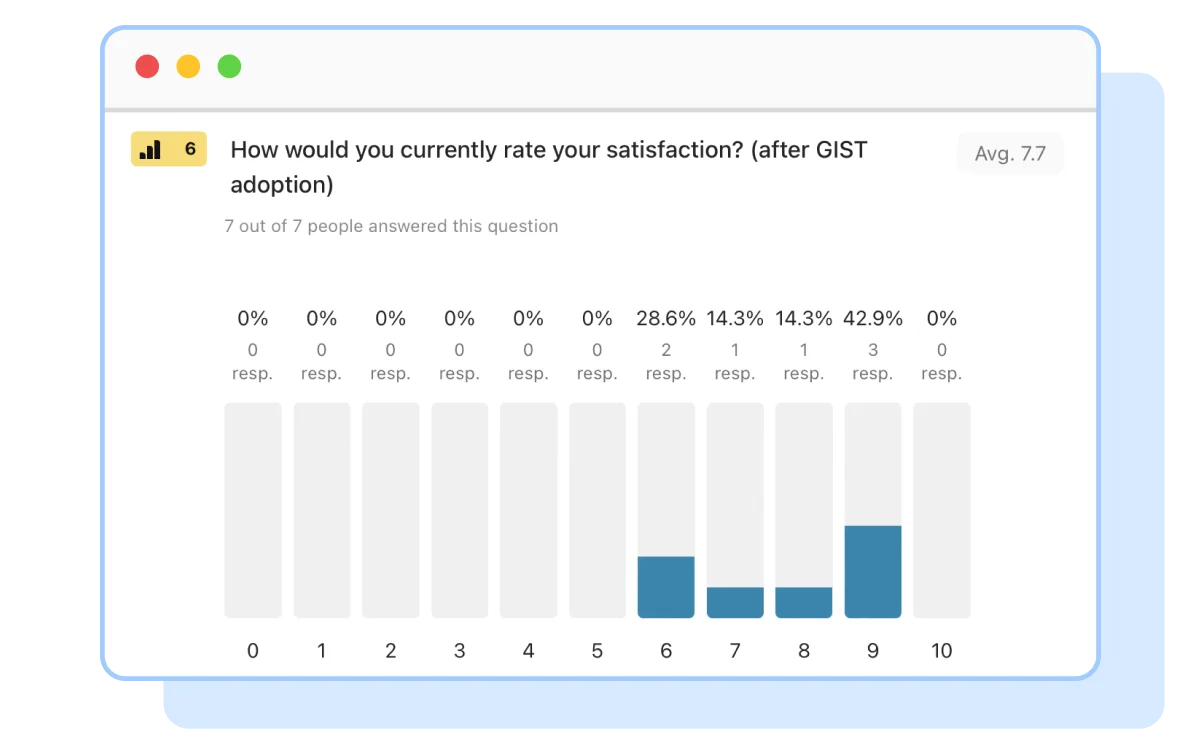
📝 Quick tips for GIST adoption 🔗
If your curiosity has peaked after reading about our GIST journey, we encourage you to try it out within your organization. Here are some things we've learned along the way:
1. Be patient 🔗
Adopting GIST is a long-term gig. As such, it won't yield immediate results, but the wait will bear fruit. Implementation requires experimentation, team buy-in, and the appropriate integration tools. "Like any framework, you cannot simply apply it to a problem and assume it will be effective," reasons our PM.
2. Focus on the bigger picture 🔗
There's no need to implement every aspect of the framework all at once. Keep in mind that GIST is meant to make things easier! In Localazy's case, we haven't yet adapted fully to ICE Scoring (Impact, Confidence, and Ease), which is the preferred task prioritization method. That, however, hasn't stopped us from adopting the GIST philosophy.
As our CMO puts it, "We are just moving ahead from a kind of small company, punk culture. There are certainly a few parts that we are not ready to absorb and use completely, but we're getting the best out of GIST to help us evolve. We have even adopted ICE Scoring in a bit of a liberal way, which allows us to move faster."
3. Work with what you already have 🔗
If you want to make it easier for team members to understand how GIST works, make sure to create good views on the tasks they already know. It will give them a fresh perspective, and it'll be easier to navigate the new landscape quickly. While you're at it, make sure that every employee sees what they want to see on their boards (and nothing else) to avoid increasing the cognitive load. 🧠
4. Do not overshoot it... 🔗
Registering goals, ideas, steps, and tasks can feel draining in the beginning. Start easy. 🧘♂️ While the groundwork is being laid down, it's important to be flexible with the team. "If there are members who prefer to work over making documentation, make sure they are not overly pushed into writing everything down. This is particularly important for the ideas phase - it's just fine to write down a one-sentence idea and develop it over time", Jakub says.
5. ...but go full-in. 🔗
It does not make sense to "just try" GIST on a few ideas. If you half-gas implementation, the system won't stick. Leaders must believe in the framework and throw themselves into it. Only then will the needle move, and the team will be able to reap the benefits.
6. Integrate other models into it 🔗
Lastly, if you have any other compatible frameworks put into place, make sure to integrate them into the bigger picture. In our case, we're still in the process of making JTBD and GIST work together. Gilad advocates for translating the findings of the first into the language of the second (ICE) in order to evaluate ideas in an objective and rational manner. "Think of user research/JBTD as the source of your ideas and evidence, and of GIST as the evaluation and validation engine," he explains.
🧐 Try it for yourself! 🔗
Learn more about GIST and how it can be implemented step by step in Itamar Gilad's new book, "Evidence-Guided." Thank you, Itamar, for sharing your time and expertise with us! 🙌
If you decide to jump on the chance of applying GIST to your own project, remember to have your CEO on board and to test the framework carefully - you'll be starting a long journey, but it will definitely bear fruit. And when things get a little hard, don't despair: remember that one call over Around with 5 minutes of Pacman can solve a lot of hard feelings. 👾🙂
